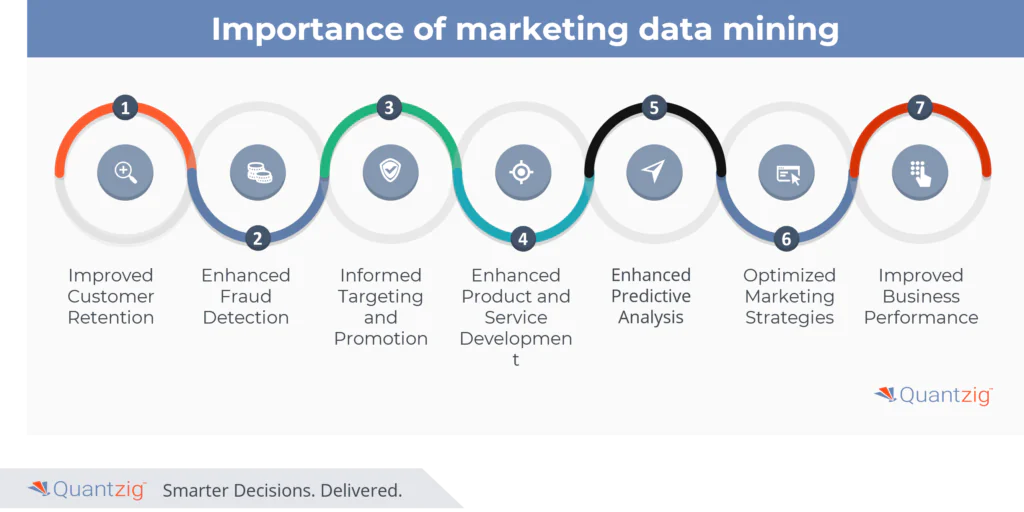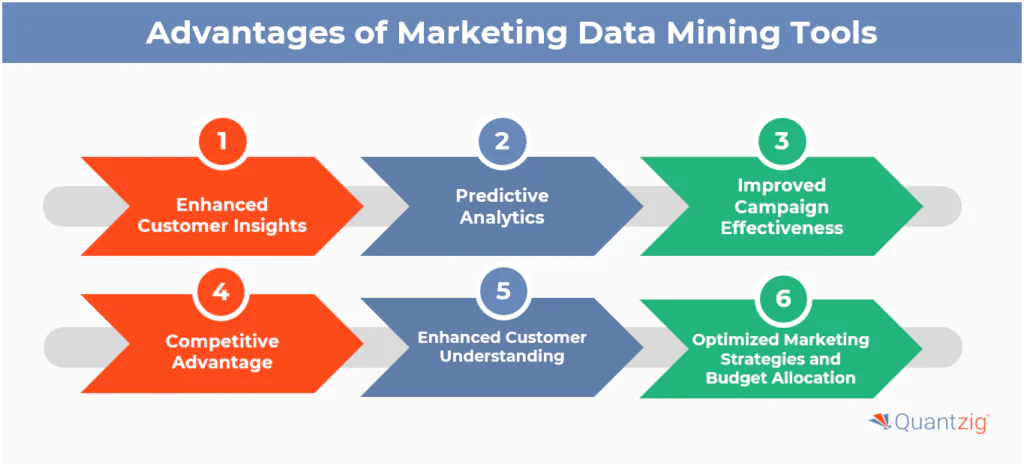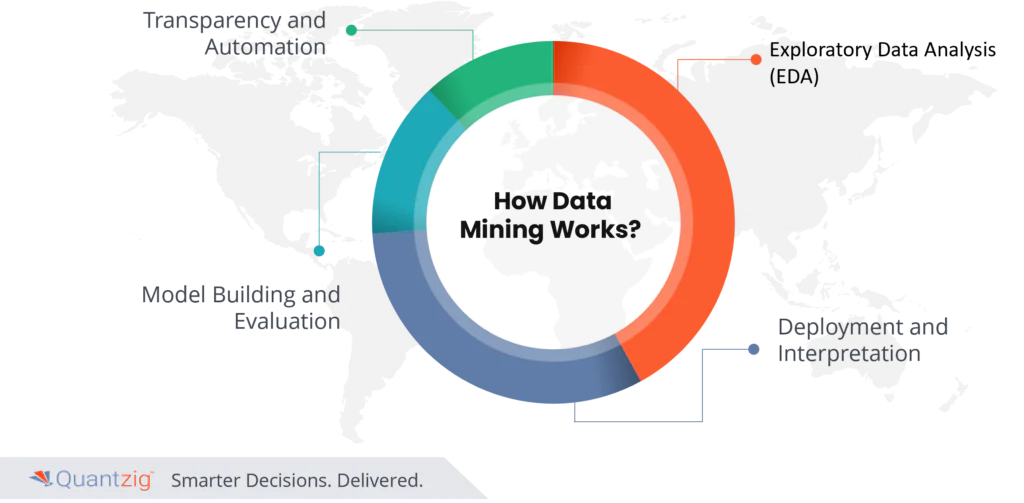Written By: Sudeshna Ghosh
Table of Contents
Key Takeaways of Marketing Data Mining
- Leveraging marketing data mining provides businesses with valuable insights into customer behavior, preferences, and market trends, empowering them to make informed business decisions that drive growth.
- By harnessing the power of this tool, businesses can personalize their marketing campaigns and offerings, effectively targeting specific customer segments and increasing engagement and conversion rates.
- This tool enables businesses to allocate resources more efficiently by identifying the most effective marketing channels and messages, maximizing ROI on marketing investments and driving sustainable growth.
- Businesses that effectively utilize marketing data mining gain a competitive edge in the market by staying ahead of trends, adapting quickly to changes, and continuously optimizing their strategies to meet evolving customer needs and preferences.
Introduction
Nowadays, a customer-focused approach has become essential to product development to get more customers and compete with other companies. To mitigate the risks associated with product development, adopting a customer-centric approach is necessary because it entails conducting thorough research to uncover customer preferences, needs, and behavioral patterns related to the product concept.
Here, data mining tools empower companies to glean invaluable information essential for product success. By delving deep into customer data, businesses can gain an in-depth understanding of both the emotional and rational benefits associated with the proposed product. Such insights not only inform strategic decision-making but also enhance the likelihood of delivering a product that resonates with the target audience, thereby maximizing market success.
Book a demo to experience the meaningful insights we derive from data through our analytical tools and platform capabilities. Schedule a demo today!
Request a Free DemoWhat is Marketing Data Mining?
Marketing Data Mining is the process of analyzing data from different perspectives in order to summarize and analyze to discover useful information. So, when firms discover the patterns or the relationships of data, they will be able to use it to increase profits or reduce costs, or both. Nowadays, firms want to increase their customers, and data mining is a good way to help firms to get more potential customers. The traditional process of marketing through advertising media costs firms a lot of money and the costs of advertising will add to the product.
This analytical process involves extracting valuable insights and patterns from vast datasets related to business intelligence data, e-commerce websites, elements of Data Mining, social media platforms, and other sources. Utilizing data visualization tools, Artificial Intelligence, data mining techniques, and various modeling approaches like descriptive modeling, predictive modeling, and prescriptive modeling, it enables businesses to uncover hidden trends, behaviors, and correlations. By incorporating data warehousing and market basket analysis, organizations can refine their marketing strategies, segment customers, and optimize resources such as marketing forecasts and advertising campaign budgets. Moreover, marketing data facilitates customer segmentation, personalization, and enhances customer satisfaction levels, ultimately driving more effective marketing campaigns and yielding higher returns on investment.
What is the Importance of Marketing Data Mining?

The importance of marketing data mining lies in its ability to drive strategic decision-making and enhance business performance through insightful analysis of consumer behavior and market trends.
1. Improved Customer Retention:
By leveraging techniques like association rule learning and pattern mining, marketing data mining enables businesses to identify factors contributing to customer churn. This insight allows for targeted retention strategies, such as personalized offers or proactive customer service, effectively reducing churn rates and fostering long-term customer loyalty.
2. Enhanced Fraud Detection:
Marketing data mining plays a crucial role in credit card fraud detection, employing methods like regression analysis to detect unusual patterns and anomalies in transaction data. This proactive approach helps financial institutions mitigate risks and protect both consumers and businesses from fraudulent activities, thereby safeguarding trust and integrity in the marketplace.
3. Informed Targeting and Promotion:
By harnessing techniques like cluster analysis, regression analysis, classification analysis, and statistical methods, marketing data mining enables businesses to identify distinct user groups and understand their preferences and behaviors. This insight allows for targeted special promotions tailored to specific segments, enhancing the effectiveness of marketing campaigns and maximizing return on investment.
4. Enhanced Product and Service Development:
Marketing data mining, utilizing focus groups and case studies, provides valuable insights into consumer needs and preferences. By analyzing complex data sets, businesses can uncover emerging trends and opportunities, guiding the development of innovative products and services that resonate with target audiences. This proactive approach fosters customer satisfaction and loyalty, driving long-term success in competitive markets.
5. Enhanced Predictive Analysis:
Leveraging techniques like predictive data-based analysis, regression analysis, and classification analysis, marketing data mining enables businesses to anticipate market trends, get data enhancement, and consumer behavior. By analyzing large databases and utilizing machine learning algorithms, organizations can identify patterns and correlations, empowering them to make data-driven predictions regarding product sale activities and market conditions.
6. Optimized Marketing Strategies:
Marketing data mining plays a crucial role in optimizing digital marketing efforts and enhancing customer engagement. By integrating data from multiple sources such as sales reports, loyalty programs, and monitoring systems, businesses can gain comprehensive insights into customer behavior and preferences across digital channels and social networks. This enables personalized marketing campaigns tailored to potential customers, increasing brand awareness and driving customer acquisition.
7. Improved Business Performance:
Through effective data integration, geographic location selection, cleaning, and transformation processes, marketing data mining enables businesses to extract valuable insights and discovered knowledge from large databases. By analyzing metrics such as the language tone in customer interactions and key performance indicators like the increased number of page views per session and average profit per check, organizations can continuously monitor and evaluate their marketing efforts. This iterative process facilitates business evolution and risk management, enabling organizations to adapt to changing market conditions and drive commercial establishment in multiple regions.
Overall, marketing data mining serves as a cornerstone in market research and real-time recommendations, providing valuable insights derived from big data to inform strategic decision-making and drive competitive advantage in today’s dynamic business landscape.
Advantages of Marketing Data Mining Tools
Some business owners may think collecting data will waste their valuable time, but the fact is when done well, data mining tools give a lot of benefits to their businesses by providing business intelligence. Some of those key benefits include:

1. Enhanced Customer Insights:
Marketing data mining tools offer businesses a comprehensive understanding of customer behavior by analyzing vast datasets. Through this analysis, companies gain insights into demographics, psychographics, and purchasing habits, enabling targeted marketing strategies and personalized customer experiences tailored to individual preferences. By leveraging these insights, businesses can effectively segment their customer base, identify high-value prospects, enhance marketing strategy, and tailor their marketing efforts to meet the specific needs and preferences of different customer segments that ultimately drive customer satisfaction and loyalty, and stay ahead from the competition.
2. Predictive Analytics:
These tools utilize advanced algorithms and machine learning techniques to forecast future trends and customer behaviors and geographic locations. By analyzing historical data and identifying patterns, these tools can predict potential market shifts, emerging trends, and customer preferences, enabling businesses to anticipate market dynamics, get data enhancement, and proactively adjust their marketing strategies. Through predictive analytics, companies can optimize resource allocation, identify growth opportunities, and stay ahead of competitors in an increasingly dynamic and competitive marketplace.
3. Improved Campaign Effectiveness:
These tools empower marketers to optimize campaign performance by identifying the most effective channels, messaging strategies, and promotional tactics. Through data-driven insights, businesses can refine their marketing efforts, maximize ROI, and enhance customer engagement, ultimately driving higher conversion rates and revenue growth. By analyzing campaign performance metrics such as click-through rates, conversion rates, and customer engagement levels, businesses can identify areas for improvement and fine-tune their marketing strategies to achieve better results and greater impact.
4. Competitive Advantage:
These tools also provide businesses with a competitive edge by uncovering hidden insights, market trends, and opportunities. By analyzing market data and competitor strategies, businesses can identify gaps in the market, untapped customer needs, and emerging trends, enabling them to develop innovative products, services, and marketing strategies that differentiate them from competitors. By leveraging these insights, businesses can position themselves as industry leaders, strengthen their brand reputation, and foster long-term customer loyalty, ultimately gaining a competitive advantage in the marketplace.
5. Enhanced Customer Understanding:
Marketing data mining tools empower businesses to delve deep into consumer behavior patterns across various channels such as e-commerce websites, social media platforms, and DEM (direct email marketing) campaigns. By leveraging data visualization tools and techniques like market basket analysis, businesses can gain invaluable insights into customer preferences, satisfaction levels, and purchasing habits. This enhanced understanding enables organizations to tailor marketing campaigns, strategies, and product offerings more effectively, ultimately driving higher customer engagement and loyalty.
6. Optimized Marketing Strategies and Budget Allocation:
These tools enable businesses to harness the power of descriptive modeling, predictive modeling, and prescriptive modeling techniques to forecast market trends, segment customers, and predict campaign outcomes. By leveraging artificial intelligence and data mining techniques, organizations can analyze market segmentation, identify patterns, and derive actionable insights to optimize marketing strategies and allocate advertising campaign budgets more efficiently. This data-driven approach ensures that marketing efforts are targeted towards the most lucrative channels and segments, maximizing ROI and driving sustainable business growth.
The advantages offered by marketing data mining tools are invaluable for businesses seeking to thrive in today’s competitive marketplace. By harnessing the power of data analytics and DEM (Direct email marketing) campaign, businesses can gain deeper insights into customer behavior, enabling them to tailor marketing strategies and enhance customer experiences. Predictive analytics capabilities allow businesses to anticipate market trends and stay ahead of the curve, while improved campaign effectiveness ensures optimized resource allocation and higher ROI. Moreover, leveraging data mining tools provides businesses with a competitive advantage by uncovering hidden insights, enhancing marketing strategy, and market opportunities, enabling them to differentiate themselves and drive long-term success. In essence, embracing marketing data mining tools is essential for businesses looking to remain agile, innovative, and stay ahead from the competition.
What are Marketing Data Mining Tools and Techniques?
Global organizations that desire to utilize data mining tools can successfully purchase mining programs such as marketing forecasts designed for existing hardware and application software platforms, and it can be integrated into new systems or products. A wide range of tools are present in the marketplace and each tool has some strengths and weaknesses that recommend businesses should buy the tools that match their requirements. Whether seeking to extract insights from structured datasets, visualize trends through intuitive dashboards, or analyze unstructured text data, organizations can leverage the appropriate tool to meet their unique analytical needs. Most of the data mining tools can be classified into three distinct categories: Traditional Data Mining, Dashboards, and Text-mining tools.
Traditional data mining tools aid organizations in data monitoring and trend identification, while others excel at capturing information beyond database confines. These programs seamlessly integrate with online analytical processing or similar technologies to streamline data utilization. Dashboards, on the other hand, are designed for installation on computers to facilitate real-time monitoring of database information. Displaying data changes and updates through visual elements like charts or tables, they offer users valuable insights into business performance. Their user-friendly interface enables managers to easily navigate and gain an overarching view of company operations. Lastly, text-mining tools can extract data from various text formats, providing users with convenient access to diverse datasets and data enhancement without multiple applications.
How Does Marketing Data Mining Work?

It is a powerful analytical process that extracts valuable patterns, trends, and insights from large datasets to inform decision-making and drive business success. Most organizations across various industries rely on data mining techniques to uncover hidden correlations, predict future outcomes, and gain a competitive edge. By leveraging advanced algorithms and statistical methods, data mining enables businesses to sift through massive amounts of data to discover meaningful patterns and relationships that would otherwise remain hidden.
Understanding how data mining works is crucial for organizations seeking to leverage their data assets effectively. By uncovering valuable insights hidden within vast datasets, data mining enables businesses to make informed business decisions, identify patterns, and predict future trends. Here, we delve into the mechanics of data mining, exploring its key principles and processes.
Step 1: Data Collection and Preparation
The data mining process begins with the collection of raw data from various sources, including databases, data warehouses, and external sources. This data is then cleansed and pre-processed to remove inconsistencies, errors, and duplicates, ensuring accuracy and reliability. Through techniques such as data normalization and transformation, the data is structured and organized for analysis.
Step 2: Exploratory Data Analysis (EDA)
Once the data is prepared, exploratory data analysis techniques are employed to gain insights into its underlying patterns and relationships. This involves visualizing the data through charts, graphs, and statistical summaries to identify trends, correlations, and outliers. By exploring the data from different perspectives, analysts can uncover valuable insights that inform subsequent modeling efforts.
Step 3: Model Building and Evaluation
With insights gleaned from exploratory analysis, data mining models are constructed to extract meaningful patterns and relationships from the data. These models utilize various algorithms and techniques, such as decision trees, clustering, and neural networks, to uncover hidden patterns and make predictions. The performance of these models is then evaluated using metrics such as accuracy, precision, and recall to assess their effectiveness in capturing the underlying structure of the data.
Step 4: Deployment and Interpretation
Once the data mining models are built and validated, they are deployed into production environments where they can be used to make predictions and generate insights in real-time. The results produced by these models are interpreted by domain experts to derive actionable insights and inform decision-making processes. Additionally, ongoing monitoring and refinement of the models ensure their continued effectiveness and relevance as new data becomes available.
Data mining is a powerful tool for unlocking the hidden value within large datasets, enabling organizations to gain actionable insights and drive informed decision-making. By following a systematic process of data collection, preparation, exploratory analysis, model building, and deployment, businesses can harness the predictive power of the elements of data mining to uncover valuable patterns, trends, and relationships that drive business success. As organizations continue to embrace data-driven strategies, understanding how data mining works will be essential for staying competitive and achieving strategic objectives in today’s rapidly evolving marketplace.
Experience the advantages firsthand by testing a customized complimentary pilot designed to address your specific requirements. Pilot studies are non-committal in nature.
Request a Free PilotWhat are the Applications of Marketing Data Mining?
Applications of Marketing Data Mining encompass a broad array of strategic initiatives aimed at enhancing business intelligence data and optimizing marketing endeavors across e-commerce websites, social media platforms, and beyond. Leveraging data visualization tools, data mining techniques, and various modeling methodologies like descriptive modeling, predictive modeling, and prescriptive modeling, it enables organizations to extract actionable insights from data warehousing initiatives and perform comprehensive market basket analysis. By harnessing the power of the elements of Data Mining, artificial intelligence and prioritizing market segmentation, businesses can refine marketing strategies, allocate resources based on marketing forecasts and advertising campaign budgets, and elevate customer satisfaction levels through targeted DEM (direct email marketing) campaigns and customization/personalization efforts, thereby achieving heightened effectiveness in marketing campaigns and business intelligence data utilization.
Data mining plays a pivotal role in extracting actionable insights from the vast pool of data generated by social media platforms. Leveraging advanced data mining techniques and data visualization tools, organizations can uncover valuable patterns and trends in user behavior and engagement. Through descriptive modeling, predictive modeling, and prescriptive modeling, businesses can anticipate user preferences and tailor marketing campaigns accordingly, enhancing customer satisfaction levels and optimizing marketing strategies. Moreover, integrating social media data into data warehousing initiatives enables comprehensive market segmentation and precise allocation of resources such as advertising campaign budgets, ultimately facilitating more effective customization/personalization efforts and driving business success.
Quantzig’s Innovative Marketing Data Mining Solutions
Quantzig’s marketing data mining solutions are engineered to unlock valuable insights from vast datasets, empowering businesses to make informed decisions and drive growth. Leveraging advanced algorithms and machine learning techniques, Quantzig’s innovative marketing strategy delve deep into complex data structures to uncover hidden patterns, trends, and correlations. By analyzing diverse data sources, including customer demographics, purchase history, and online behavior, our experts enable businesses to gain a comprehensive understanding of their target audience and market dynamics. Through predictive analytics, our solutions forecast future trends and customer behaviors, enabling proactive decision-making and strategic planning. Whether it’s optimizing marketing campaigns, enhancing customer segmentation, or identifying growth opportunities, Quantzig empowers businesses to harness the power of data mining for sustainable success.
Furthermore, our marketing data mining solutions offer seamless integration with existing systems and workflows, ensuring a smooth transition and minimal disruption to business operations. With a user-friendly interface and intuitive features, we make it easy for businesses to access and interpret complex data insights. Moreover, our team of experienced data scientists and industry experts provide comprehensive support and guidance throughout the implementation process, ensuring that clients derive maximum value from their investment in data mining technology. From data preprocessing and model development to performance monitoring and optimization, Quantzig’s end-to-end solutions streamline the data mining process and empower businesses to drive growth and innovation and stay ahead from the competition.
Also Read: Building an Effective e-Commerce Business Strategy with the Help of Web Mining and Text Analytics
Get started with your complimentary trial today and delve into our platform without any obligations. Explore our wide range of customized, consumption driven analytical solutions services built across the analytical maturity levels.
Start your Free Trial TodayWhat Does the Future of Marketing Data Mining Hold?
Under marketing data mining, regression analysis and classification analysis are poised to play pivotal roles in identifying patterns and trends to better target potential customers. By leveraging geographic location data and sales histories, businesses can enhance data entry processes and develop targeted marketing proposals tailored to specific regions and consumer segments. This approach allows organizations to weigh the costs and benefits associated with marketing initiatives more effectively, enabling the evolution of the business in alignment with revenue goals and market trends. Furthermore, Information Technology Professionals adept in data mining elements and analytical reports are instrumental in leveraging relational databases to extract valuable insights from CRM systems, driving informed decision-making and optimizing marketing strategies for maximum impact.
Looking ahead, the future of marketing data mining holds promising opportunities for innovation and growth. As businesses continue to invest in advanced technologies and analytical tools, the emphasis on model performance and model validation will become increasingly important. Data exploration techniques will enable organizations to uncover hidden patterns and correlations, paving the way for more targeted and personalized marketing campaigns. Moreover, the integration of analytical reports with CRM systems will empower businesses to streamline operations and enhance customer engagement, ultimately driving revenue totals to new heights. In this dynamic landscape, staying abreast of emerging trends and embracing data-driven strategies will be paramount for businesses seeking to thrive in the ever-evolving market environment.
Conclusion
In conclusion, harnessing the power of marketing data mining is essential for driving growth and achieving strategic objectives in today’s competitive business landscape. By extracting actionable insights from vast datasets, businesses can make informed decisions, predict customer behaviors, and optimize marketing strategies. This enables enhanced customer engagement, increased conversion rates, and sustainable revenue growth. As organizations continue to embrace data-driven approaches, investing in advanced analytics tools and refining data mining processes will be crucial for maintaining a competitive edge and driving long-term success in the digital age.



